VMHaunman
Hanuman Jayanti![]() (Video of Hanuman Jayanti fire puja)
(Video of Hanuman Jayanti fire puja)
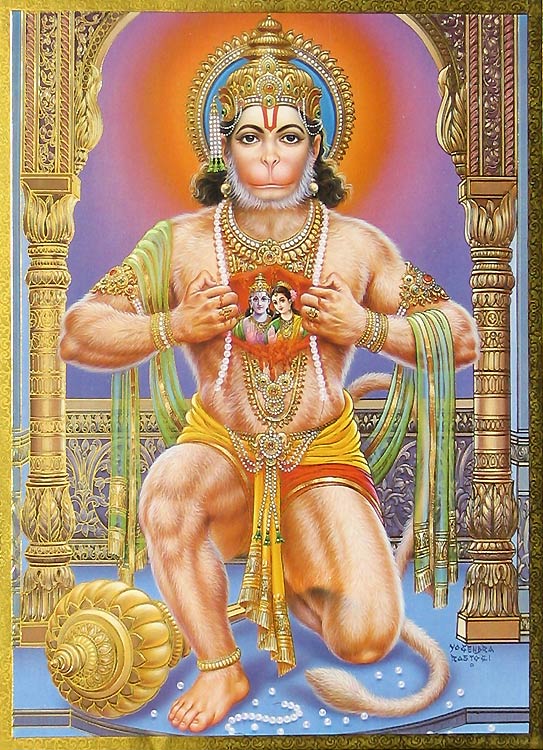 Hanuman Jayanti is the festival that commemorates the birth of Hanuman, the monkey God who unquestioningly served Lord Rama. It is because of this unfaltering devotion that Hindus pray to Hanuman. He represents energy and strength and is regarded as one of the most powerful Gods because he can take almost any form. During the festival, Hindus will go to the temple very early in the day and pray to Hanuman. Because Hanuman was born at sunrise, during the festival, prayers are stopped at sunrise and Prasad (holy offering of food) is served in his honor. The festival usually falls in the western calendar’s month of April, but this can vary since the Hindu calendar is based on lunar cycles.
Hanuman Jayanti is the festival that commemorates the birth of Hanuman, the monkey God who unquestioningly served Lord Rama. It is because of this unfaltering devotion that Hindus pray to Hanuman. He represents energy and strength and is regarded as one of the most powerful Gods because he can take almost any form. During the festival, Hindus will go to the temple very early in the day and pray to Hanuman. Because Hanuman was born at sunrise, during the festival, prayers are stopped at sunrise and Prasad (holy offering of food) is served in his honor. The festival usually falls in the western calendar’s month of April, but this can vary since the Hindu calendar is based on lunar cycles.
VMHoli
Holi![]() (Video of celebrative dancing at Holi)
(Video of celebrative dancing at Holi)
Known as the Festival of Colors, Holi is a Hindu festival celebrated throughout India and other areas with a major Hindu influence, such as North America, Europe, Africa and other parts of southern Asia. According to Hindu tradition, the demon king, Hiranyakashipu, was granted “eternal life” from Brahma. The boon (blessing) stipulated that Hiranyakashipu could not be killed during the day or night, inside or outside his home, on earth or in the sky, or by man nor animal. Because of this protection, Hiranyakashipu grew arrogant and denounced the Gods and ordered everyone to pray to him. Prahlada, Hiranyakashipu’s son, was a devout follower of Lord Vishnu and became upset at the outrageous claims his father was making. Hiranyakashipu ordered Prahlad not to worship Vishnu but Radhu persisted. Hiranyakashipu then tried unsuccessfully to have his son killed, as Prahlada survived poisoning, trampling, biting and fire. In one incident Prahlad and his sister were induced to sit on a pyre. Holika, who was believed to be immune to fire, was consumed while Prahlad was unscathed. It is in Holika’ memory that the festival is celebrated under the name Holi. It was then that Lord Vishnu took action. He came in the form of a half man-half lion, and killed Hiranyakashipu at dusk on the porch, killing him on his lap, thus avoiding the boons that protected Hiranyakashipu.
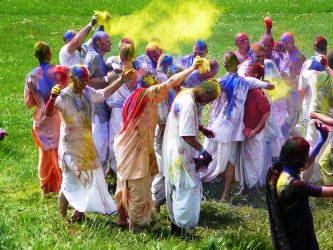 Holi is celebrated at the end of the winter season and the beginning of spring, usually February or March, during the last full moon day of the Hindu month of Phalguna. Like most festivals, it lasts for several days, and in some areas is celebrated for several weeks. Holi is celebrated in a variety of ways in different countries, but there are a number of common rituals. A bonfire is also typical of Holi; participants will gather around the fire, which symbolizes the death of the demons and demonesses. One of the most distinctive rituals involves participants throwing colored powder and water on one another, which is why the holiday is referred to as the Festival of Colors.. In more traditional cultures, it was the ashes of the bonfire that were used during the color throwing ceremony. Holi is also a time of feasting, and those participating in the festivities begin to prepare lavish meals well in advance of the celebration. The holiday is noted for a suspension of social distinctions based on gender, caste, social status, and age as well as social norms governing conventional propriety, which creates a carnivalesque atmosphere.
Holi is celebrated at the end of the winter season and the beginning of spring, usually February or March, during the last full moon day of the Hindu month of Phalguna. Like most festivals, it lasts for several days, and in some areas is celebrated for several weeks. Holi is celebrated in a variety of ways in different countries, but there are a number of common rituals. A bonfire is also typical of Holi; participants will gather around the fire, which symbolizes the death of the demons and demonesses. One of the most distinctive rituals involves participants throwing colored powder and water on one another, which is why the holiday is referred to as the Festival of Colors.. In more traditional cultures, it was the ashes of the bonfire that were used during the color throwing ceremony. Holi is also a time of feasting, and those participating in the festivities begin to prepare lavish meals well in advance of the celebration. The holiday is noted for a suspension of social distinctions based on gender, caste, social status, and age as well as social norms governing conventional propriety, which creates a carnivalesque atmosphere.
Profile prepared by Josh Jolly
May, 2009
VMKumbhMella
Kumbh Mela![]() (Video of Kumbh Mela celebration)
(Video of Kumbh Mela celebration)
Kumbh Mela is a festival during which Hindus make a pilgrimage to sacred locations in India. Hindu legend states that at one time the Gods lost their strength. They believed churning the Ocean of Milk
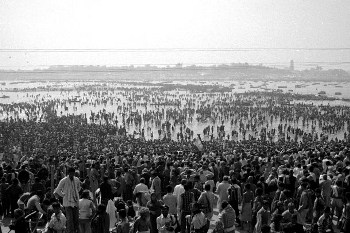 would give them amrit (the nectar of life) that would help them regain their powers. In order to accomplish this goal, they needed the assistance of their enemies, the demons of the world. In return for the demons’ help, the Gods agreed that they could share the amrit equally. However, when the amrit appeared, the Gods and demons fought over it in the sky. It is said that four drops of amrit spilled and landed on four different spots, Allahabad, Haridwar, Ujjain and Nashik.
would give them amrit (the nectar of life) that would help them regain their powers. In order to accomplish this goal, they needed the assistance of their enemies, the demons of the world. In return for the demons’ help, the Gods agreed that they could share the amrit equally. However, when the amrit appeared, the Gods and demons fought over it in the sky. It is said that four drops of amrit spilled and landed on four different spots, Allahabad, Haridwar, Ujjain and Nashik.
The event occurs four times every 12 years, and the sites that Hindus visit rotate between Allahabad, Haridwar, Ujjain and Nashik. Ever
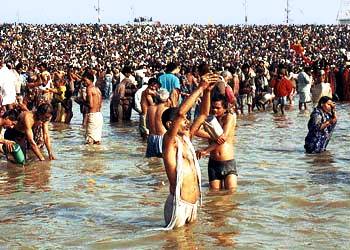 144 years, there is what is known as the Great Kumbh Mela, and in 2001 60 million Hindus journeyed to Allahabad, making it the largest gathering anywhere in the world. It is part of the ritual that those that travel bathe in the waters of the river of each city. The festival also consists of eating food that is even given to the poor, singing of songs, and religious discussions.
144 years, there is what is known as the Great Kumbh Mela, and in 2001 60 million Hindus journeyed to Allahabad, making it the largest gathering anywhere in the world. It is part of the ritual that those that travel bathe in the waters of the river of each city. The festival also consists of eating food that is even given to the poor, singing of songs, and religious discussions.
Profile prepared by Josh Jolly
May, 2009
VMLohri
Lohri ![]() (Dance celebration of Lohri)
(Dance celebration of Lohri)
Lohri is the harvest festival that is celebrated in Northern India in the lunar month of Paush, which
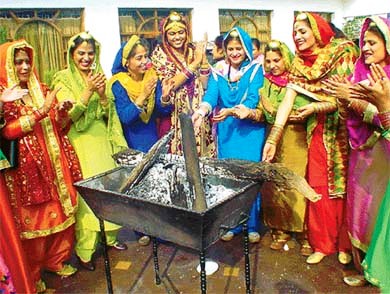 corresponds to December/January. In the Punjab region, wheat is the main crop, and between planting and harvesting the wheat, there is a major celebration. It is widely regarded as the Indian equivalent of Thanksgiving. Typically there is a massive bonfire around which locals will gather to dance, tell stories and enjoy a feast. Dulla Bhatti is a central figure in Lohri songs of celebration. He was a Muslim version of Robin Hood who would steal from the rich and give to those less fortunate, save girls from being sold into slavery, and pay for these same girls’
corresponds to December/January. In the Punjab region, wheat is the main crop, and between planting and harvesting the wheat, there is a major celebration. It is widely regarded as the Indian equivalent of Thanksgiving. Typically there is a massive bonfire around which locals will gather to dance, tell stories and enjoy a feast. Dulla Bhatti is a central figure in Lohri songs of celebration. He was a Muslim version of Robin Hood who would steal from the rich and give to those less fortunate, save girls from being sold into slavery, and pay for these same girls’
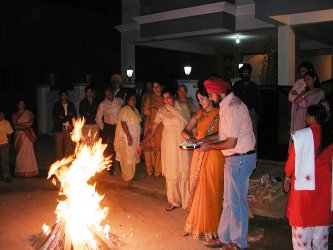
weddings. He became known as a hero throughout the state of Punjab. In the morning, young boys go to neighbors’ homes and sing tales of Dulla Bhatti. The boys are rewarded with treats and sometimes money. If a family does not give something to the boys, it is regarded as inauspicious.
Profile prepared by Josh Jolly
May, 2009
VMMahashivaratri
Mahashivaratri![]() (Various depictions of Lord Shiva)
(Various depictions of Lord Shiva) ![]() (Celebrative dancing at Mahashivaratri)
(Celebrative dancing at Mahashivaratri)
Mahashivaratri (the night of Shiva) is a Hindu festival celebrated in the lunar month of Phalguna, which corresponds to February or March. Lord Shiva is worshiped during this festival for saving humanity. During the churning of the ocean) by both gods and demons, a toxic poison was released that threatened to wipe out both humanity and the gods. The gods beseeched Lord Shiva, on the advice of Lord Vishnu, to protect their lives by ingesting the poison. Lord Shiva agreed to drink the poison, but its effects were so potent that Chandra (the Moon God) intervened and placed a cobra around his neck to cool the effects of the poison. It was as a result of this experience that Shiva assumed a blue color.
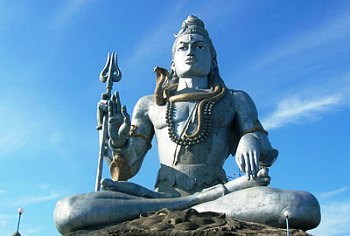 The festival is celebrated by Hindu’s, who fast for the whole day and attend temple and pray in honor of Lord Shiva. They offer bael leaves, along with food and sweets to Lord Shiva as a sign of love and respect (it is also seen as very auspicious), and maintain a vigil that lasts through the night. Hindus often draw three white lines on their foreheads with a paste, symbolizing spiritual knowledge, purity and penance as a sign of respect for Shiva as well. The purpose of the festival is to receive positive energy and karma for meditation.
The festival is celebrated by Hindu’s, who fast for the whole day and attend temple and pray in honor of Lord Shiva. They offer bael leaves, along with food and sweets to Lord Shiva as a sign of love and respect (it is also seen as very auspicious), and maintain a vigil that lasts through the night. Hindus often draw three white lines on their foreheads with a paste, symbolizing spiritual knowledge, purity and penance as a sign of respect for Shiva as well. The purpose of the festival is to receive positive energy and karma for meditation.
Profile prepared by Josh Jolly
May, 2009
